Whether you’re using engine oil in a mechanical workshop, on a remote mining site, or on the factory floor, it’s important for your staff to know how to clean up an oil spill in the workplace. An oil spill can cause a range of hazards including property damage, human harm and environmental contamination. And while the term ‘oil spill’ may make you think of an oil tanker running aground in the middle of the ocean, a spill in your workplace could be something as simple as a leaking forklift engine or drums being toppled in your chemical store. So, how can you clean up a workplace oil spill quickly and safely? In this blog, we’ll look at the properties of oil and suggest measures that you can take to contain and manage your spill. We’ll also give you tips of preventing oil spills, so you can better protect your business from chemical hazards.
Types Of Oils Used In The Workplace
Oil, otherwise known as petroleum, is a hydrocarbon chemical substance that is brown in colour and insoluble in water. In the workplace, oil is primarily found in the form of fuel (through the conversion of crude oil to petrol, diesel, kerosene, benzene etc) or as a lubrication product (engine or motor oil).
Properties Of Oil
Oil is a viscous and volatile petrochemical which is recognised in Australia as a Class 3 Combustible Liquid. When oil is kept at temperatures greater than 150 °C, it will give off enough hazardous vapours to create and sustain a fire — if an ignition source is present.
While not as flammable as other Class 3 Flammable Liquids, this Class C2 combustible chemicals must still be handled and stored in a way that reduces the risk of ignition.
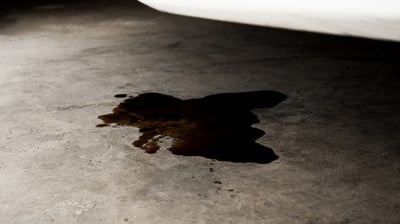
Engine oil is a combustible liquid which has the potential to ignite in the presence of an ignition source.
Oil is an ideal substance for lubricating the engines of workplace equipment, vehicles and marine craft due to its density and viscosity. However, the properties of this substance also create a unique set of difficulties for staff who are attempting to clean-up the leak or spill.
Problems Associated With Workplace Oil Spills
While the flashpoint of oil is higher than other flammable substances such as petrol, oil is still capable of igniting if there is an ignition source present in the workplace.
There is also a risk that the hazardous vapours released from oil will create an unsafe working environment due to airborne contaminants.
If oil is accidently released from a jerry can, chemical container or drum, it can result in a variety of chemical hazards including:
- Fire or explosion – You must never have ignition sources, such as flames or sparks, near oil handling or storage areas. Oil can ignite in certain circumstances, such as a match being thrown on an oil leak or flammable vapours igniting at high temperatures.
- Asphyxiation – when oil emits hazardous vapours, it can affect the respiratory system or workers and cause acute health effects. Any exposure to fumes, particularly in the event of a workplace fire, can result in acute or chronic illness
- Human harm – engine oil should never make contact with the eyes or the skin. Anyone responding to the oil leak or spill must be equipped with the correct personal protective equipment (PPE)
- Environmental pollution – spilled oil can pollute soil, waterways, groundwater supplies and the natural environment if it reaches the outdoor environment or travels down drains or sewers
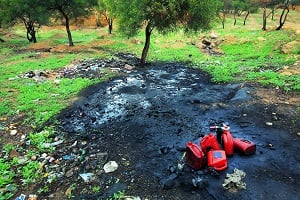
Chemical spills can cause serious environmental damage including the pollution of soil and waterways.
Additional Considerations
In the event of an oil leak or spill in the workplace, there is also the challenge of cleaning up this thick and heavy substance. This chemical product will leave an oily residue on everything that it encounters, which makes it extremely difficult to remove. You will have to be equipped to properly clean-up the spill site, including floors, walls, work benches, equipment and any surface that’s been affected by the spill.
During this process you must be extremely careful not to wash the oil into the outdoor environment or down any drain, as this will create further hazards such as ignition or pollution.
Choosing An Oil Spill Kit
If you are carrying oil in your workplace, you have a legal obligation to provide spill containment and management. To manage any unexpected oil leaks or spills, you need to be prepared for the clean-up of your site and the compliant disposal of chemical waste.
A general purpose or chemical spill kit is not always capable of effectively cleaning up a fuel or oil spill. Therefore, you must select a spill kit which is specifically designed for this type of chemical product.
A hydrocarbon spill kit is the preferred spill kit for workplace oil spills and leaks. Hydrocarbon spill kits are manufactured with ultra-absorbent pillows, pads and/or matts, which are suitable for soaking up substances such as oil and fuel. The kit should also feature a granulated floor sweep that allows for the fast absorption of hydrocarbon liquids.
If you are assembling your own hydrocarbon kit, make sure that all materials and equipment are compatible with the oil product that you’ll be cleaning up.
Using A Hydrocarbon Spill Kit
General steps that must be taken to successfully clean up an oil spill include actioning your spill response plan, making sure that all relevant staff are fully dressed in the appropriate PPE and that your spill kits and Safety Data Sheet are readily available for the spill clean-up.
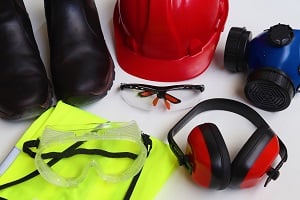
Refer to the SDS of your chemicals to determine the PPE required for your oil clean-up.
We’ll go into further detail about these oil spill clean-up steps below.
IMPORTANT: Refer to your organisation’s Spill Response Plan to determine the steps you should take when dealing with an oil leak or spill in your business. Make sure that any staff that may be tending to the oil spill receive the proper training and that the clean-up is performed under strict supervision.
Action Your Spill Response Plan
When there is an oil or chemical spill in your organisation, the last thing you want is untrained staff entering the spill site and attempting to assist. You also don’t want to ignore the spill, only for staff to continue working in hazardous conditions.
As soon as a spill is noted at your site, you should immediately action your Spill Response Plan. This usually requires notifying the relevant (trained) staff and supervisors, accessing the chemical’s Safety Data Sheet and dressing in compliant PPE.
Dress In Appropriate PPE
When cleaning up an oil spill, your staff should be dressed in the appropriate PPE as specified in your Safety Data Sheet — and determined by your workplace risk assessment.
PPE for an oil leak or spill clean-up may include the following items:
- Protective eyewear
- Nitrile gloves
- Protective clothing and footwear
- Breathing apparatus
Stop The Spill From Spreading
Depending on the quantity of liquid leaked or spilled, you will have to immediately act to stop the oil spill from travelling further through the workplace. If it’s safe for your staff to do so, make sure spill control equipment and absorbents (such as matts or pillows) are placed across the spill zone. You can also put down booms to stop the liquid from spreading further into the workplace.
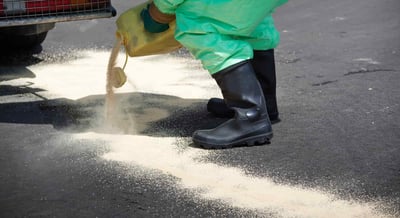
You must stop the oil from spreading through your workplace as this increases the risk of human harm, ignition and environmental contamination.
Due to the threat of environmental contamination, make sure that any drains, sewers or stormwater systems are plugged or covered, so that oil can’t contaminate the outside environment.
REMEMBER: If your spill is too large or dangerous for your staff to clean-up, you must immediately notify emergency services and action your Incident Management Plan. It is also your responsibility to notify Workplace Health and Safety of any hazardous incidents in your organisation.
Isolate and Remove Ignition Sources
As hazardous and flammable vapours will be emitted from the spilled oil, the fast containment of the spill is fundamental for a safe and successful clean-up. You should ensure that the affected area is isolated from any types of ignition sources — and that no unathorised staff enter the area while the clean-up is underway.
As oil can ignite if a flame or spark is introduced to the environment, the isolation of ignition sources is essential when dealing with an oil spill clean-up.
Clean-Up The Contaminated Oil
Now that your staff are dressed in the appropriate PPE, they can tend to the actual clean-up of the spilled oil. Equipment such as shovels, yard brooms and scoops can also assist with the removal of contaminated oil from the site.
Disposal Of Chemical Waste
Use the appropriate waste disposal bags provided in your oil spill kit for the clean-up and disposal of the spilled chemicals.
Any waste that is a result of the oil spill must be handled and disposed of in a compliant manner. Licensed waste disposal contractors should be called upon so that they can dispose of the chemical waste, along with the soiled absorbent materials, clothing and other items used to clean-up the workplace oil spill.
Record The Spill Incident
Even small chemical spills should be recorded so that your workplace has an accurate record of any hazardous events that may occur.
As part of your report, you should also investigate the cause of the spillage, so you can identify and implement control measures to reduce the risk of the oil spill reoccurring in your workplace.
Oil Spill Prevention
While preparing for an oil leak or spill is part of your legal responsibilities, it’s also vital that you have the equipment, procedures and training in place that will reduce the risks associated with chemical spills.
Some tips to reduce the likelihood and impact of an oil spill include:
- Only allow trained staff to handle, decant or transfer oil in your workplace
- Make sure that oil drums are inspected upon arrival at your organisation and transferred immediately to your storage area
- Use bunded storage, such as oil drum bunds, to keep your oil from spilling
- Don’t overstock your chemical stores as excess chemicals can increase spillage risk
- Transfer your chemicals with bunded drum dollies to reduce the likelihood of a spill
- Make sure that all decanting and pumping equipment is in good condition and fit-for-purpose
- Use an all-in-one lubrication station for the safe storage and dispensing of oil lubricants
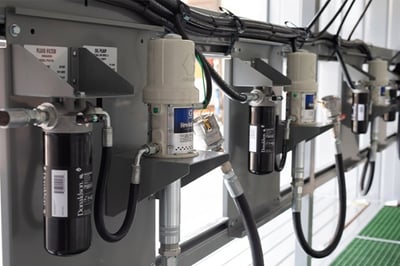
Controls, such as lubrication stations, can decrease the risks associated with using oil in the workplace.
Cleaning Up A Workplace Oil Spill
As we’ve highlighted in this blog, choosing a hydrocarbon spill kit is just one of the measures necessary for the effective clean-up of an oil leak or spill in the workplace. To ensure that your organisation is protected from the risks associated with chemical spills, we’ve created a helpful and easy-to-read eBook. Investigating Incidents Involving Hazardous Chemicals will help you accurately assess risk in your workplace and determine the correct controls that you will need to put in place. Access your copy today and reduce the risk of oil spills in your organisation.
Joining the team as a Dangerous Goods Storage Consultant, Melissa Hampton became Storemasta's Marketing Manager in late 2021. With extensive knowledge and experience in chemical compliance, Melissa is responsible for leading the Marketing team and helping shape their marketing strategy. In her spare time, you can find Melissa hiking, swimming and enjoying the great outdoors in beautiful north-west Tasmania.
